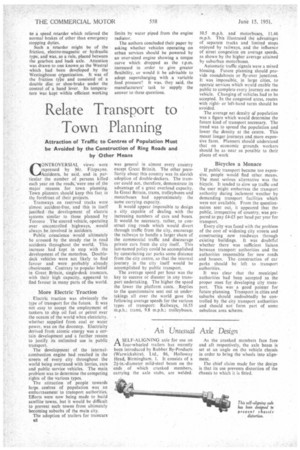Relate Transport to Town Planning
Page 42

If you've noticed an error in this article please click here to report it so we can fix it.
Attraction of Traffic to Centres of Population Must be Avoided by the Construction of Ring Roads and by Other Means CONTROVERSIAL views were expressed by Mr. Fitzpayne. Accidents, he said, and in particular the number of persons killed each year on the roads, were one of the major reasons for town planning. Town planners should keep this fact in the forefront of their projects. Tramways on reserved tracks were almost accident-free, and this in itself justified the development of electric systems similar to those planned by Toronto The steered vehicle, operating over uncontrolled highways, would always be involved in accidents. Public conscience would ultimately be aroused by the steady rise in road accidents theoughout the world. This increase had kept in step with the development of the motorbus. Doubledeck vehicles were not likely to find favour and were probably already obsolescent. Contrary to popular belief in Great Britain, single-deck tramcars, with their high capacity, appeared to find favour in many parts of the world.
More Electric Traction Electric traction was obviously the type of transport for the future. It was not easy to accept the employment of tankers to ship oil fuel or petrol over the oceans of the world when electricity. whether supplied from coal or water power, was on the doorstep. Electricity derived from atomic energy was a certain development and a further reason to justify its unlimited use in public transport. The development of the internalcombustion engine had resulted in the streets of every city throughout the world being overtaxed with lorries, cars and public service vehicles. The main problem was to determine the competing rights of the various types. The attraction of people towards large centres of population was an embarrassment to transport authorities. Efforts were now being made to build satellite towns, but it would be difficult to prevent such towns from ultimately becoming suburbs of the main city.
The adoption of trailers for tramcars s8
was general in almost every country except Great Britain. The other peculiarity about this country was its slavish adoption of doubk-deekers. The tramcar could not, therefore, demonstrate its advantage of a great overload capacity. In Great Britain, trams, trolleybuses and motorbuses had approximately the same carrying capacity. It would appear impossible to design a city capable of dealing with the increasing numbers of cars and buses. It would be necessary, rather, to construct ring roads which would divert through traffic from the city, encourage the railways to handle a larger share of the commercial traffic and discourage private cars from the city itself. This last-named policy could be accomplished by constrbcting ear parks some distance from the city centre, so that the internal journey in the city itself would be accomplished by public transport. The average speed per hour was the key to success or disaster in any transport undertaking. The higher the speed the lower the platform costs. Replies to the questionnaire sent out to undertakings all over the world gave the following average speeds for the various types of transport: Railways, 16.55 m.p.h.: tram, 9.8 m.p.h.; trolleybuses, 10.5 m.p.h. and motorbuses, 11.46 m.p.h. This illustrated the advantages of separate tracks and limited stops enjoyed by railways, and the influence of street congestion on average speeds. as shown by the higher average attained by suburban motorbuses. Automatic traffic signals were a mixed blessing. Future planning should provide roundabouts or fly-over junctions. It was impossible, in large cities, its operate services which would enable the public to complete every journey on one vehicle, Changing of vehicles had to be accepted. In the congested areas, routes with rightor left-hand turns should be avoided. The average net density of population was a figure which would determine the future kind of transport necessary. The trend was to spread the population and lower the density at the centre. This meant longer journeys and more expensive fares. Planners should understand that on economic grounds workers should be as near as possible to their places of work Bicycles a Menace • If public transport became too expensive, people would find other means. The most serious alternative was the bicycle. It tended to slow up traffic and the user might embarrass the transport authority during inclement weather by demanding transport facilities which were not available. From the questionnaires sent out, it appeared that the public, irrespective of country, was prepared to pay E4-.E5 per head per year for transport. Every city was faced with the problem of the cost of widening city streets and constructing new roadways through existing buildings. It was doubtful whether there was sufficient liaison between transport authorities and the authorities responsible for new roads and houses. The construction of car parks should be left to transport authorities. It was clear that the municipal authorities had been accepted as the proper ones for developing city transport. This was a good pointer for future planning. Transport in cities and suburbs should undoubtedly be controlled by the city transport authorities and should not form part of some nebulous area scheme.




























































































